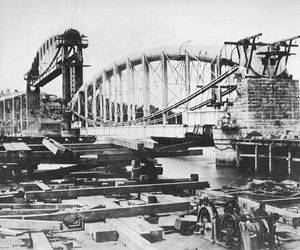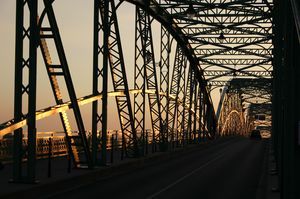Truss Bridge - Types, History, Facts and Design
Truss bridge is a type of bridge whose main element is a truss which is a structure of connected elements that form triangular units. Truss is used because it is a very rigid structure and it transfers the load from a single point to a much wider area. Truss bridges appeared very early in the history of modern bridges and are economic to construct because they use materials efficiently.
Before Industrial revolution (19th century), almost all bridges in use were made of stone. But wood and iron can resist tension and compression better and stone and United States had much wood so they made many wooden bridges in those times and most of them were truss bridges. Town's lattice truss, a very simple variant of truss, was patented in 1820. First half of 19th century saw very few truss bridges made of iron although the first patent for an iron truss bride was issued to Squire Whipple in 1841. But metal slowly started to replace wood, and wrought iron bridges started appearing in the U.S. in the 1870s only to be replaced by steel in 1880s and 1890s. In time some places (like Pennsylvania) continued building truss bridges for long spans well into 1930s, while other (like Michigan) started building standard plan concrete girder and beam bridges.

From the first truss bridge, engineers experimented with different forms of truss bridges trying to find better shape and the one that will suit them for the particular problems. Because of that we have today many forms of truss bridges. Truss bridge can have deck (roadbed) on top (deck truss), in the middle (through truss), or at the bottom of the truss. If the sides of the truss extend above the roadbed but are not connected, it is called a pony truss or half-through truss.
Here are some more common variants of truss design for bridges:
- Allan truss: a pony truss based on Howe truss. The first Allan truss was finished on 13 August 1894.
- Bailey truss: made for military to be easily combined in various configurations.
- Baltimore truss: made like Pratt truss but it has additional bracing in the lower section of the truss which prevents buckling in the compression members.
- Bollman truss: an all-metal truss with many independent tension elements which makes for a strong bridge that is easy to assemble.
- Burr arch truss: a combination of an arch and truss which gives a strong and rigid bridge.
- Howe truss: has vertical elements and diagonals that slope up towards the center of the bridge.
- K truss: has one vertical member and two oblique members in each panel (which form a letter “K”).
- Lenticular truss: uses a lens-shape truss which has an upper and lower curve and diagonal elements between them. If the curves are above and below the roadbed it is a “lenticular pony truss”.
- Long truss: a variant of Howe truss but made of wood and used for covered bridges.
- Parker truss: a variant of Pratt truss that has a polygonal upper chord. If chord has exactly five segments it is called camelback.
- Pegram truss: has chords that are wider at the bottom but of the same length as each other at the top.
- Pratt truss: has vertical members and diagonals that slope downward to the center. It is a variant commonly used for railroad bridges.
- Vierendeel truss: has members that are not triangular but rectangular. Rare are bridges made in this variant of truss because it is not cheap.
- Warren truss: has longitudinal members joined only by angled cross-members. They form equilateral triangles. It is relatively light but strong and economical truss.


